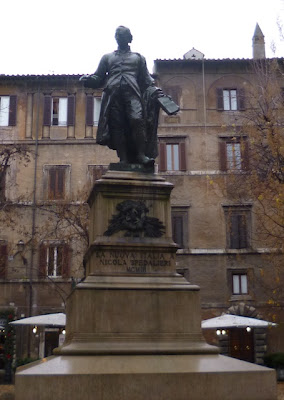Just outside the
Piazza Navona is the
Chiesa Nuova,
a church rebuilt in the 1500s for St. Philip Neri's new order. He was a
highly original and vivid character who loved humility. He had his
followers, especially the rich ones, parade through the streets of Rome
in rags or with a fox tail tied to their backs. He himself was a bit of a
jester and remains one of the more beloved Counter-Reformation saints.
 |
| Chiesa Nuova |
Also in the neighborhood is a statue dedicated to
Nicola Spedalieri,
a priest born in 1740 who died in 1794. He was a theologian and
philosopher who wrote a treatise against Gibbons's claim that
Christianity caused the fall of the Roman Empire. Another treatise
Spedalieri wrote against the French Revolution's "Rights of Man" became
very controversial. He died of poisoning, though who did him in is still
a mystery.
 |
| Statue of Nicola Spedalieri |
Nearby is a statue named
Pasquino. The statue is thought to be from an ancient group of statues depicting a scene from the
Iliad. The statue had been used for a long time as a paving stone but was eventually put up in 1501. A shoe-maker (or possibly a tailor, different stories tell different tales) named Pasquino had a shop nearby. He liked to make satirical comments about things and this was unpopular with local authorities. He took to writing out his comments and hanging them on the statue at night so he could plausibly deny it was him. The practice became popular and others hung their comments as well. Soon other statues in the area also had comments appearing overnight. At one point, the Pasquino statue had a dialog going with two other statues! Nowadays, signs only go up on rare occasions.
 |
| Pasquino statue |






No comments:
Post a Comment